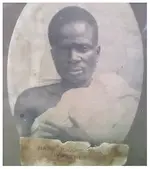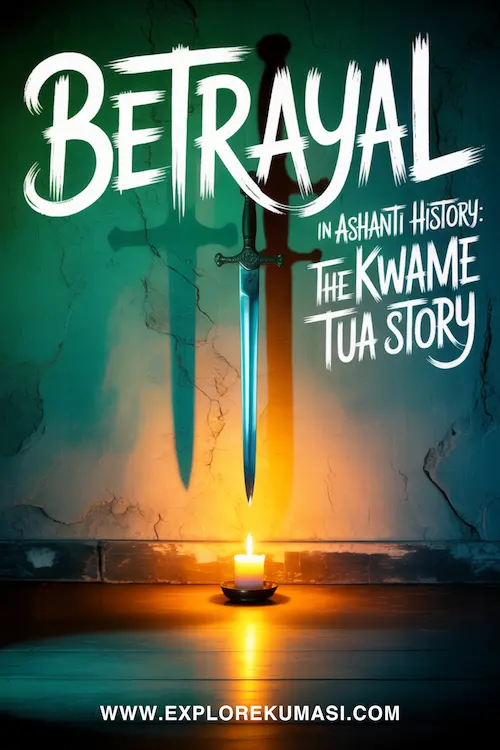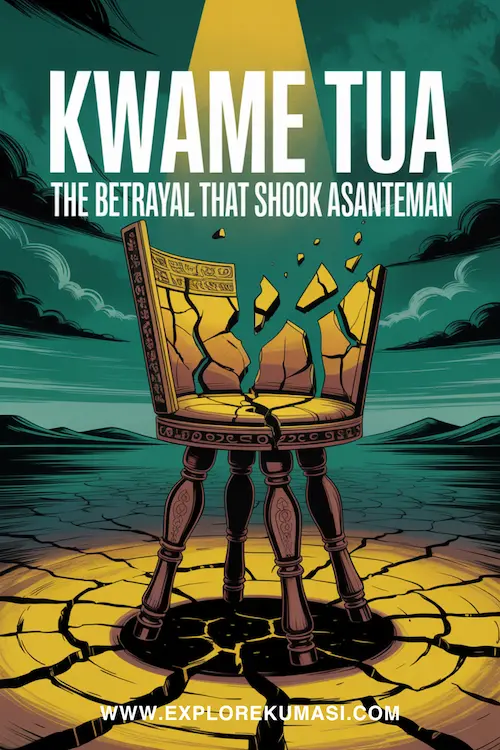Kwame Tua: The Great Betrayer of the Ashanti and the Tragedy of Trust

THIS POST MAY CONTAIN AFFILIATE LINKS. THIS MEANS WE MAY RECEIVE A COMMISSION FROM QUALIFYING PURCHASES YOU MAKE THROUGH OUR LINKS. KINDLY READ OURDISCLOSURE NOTICE FOR MORE INFORMATION.
What happens when one person’s actions break the trust of a whole nation? The story of Kwame Tua, often called “the great betrayer” or “the Judas of Asanteman,” still stirs strong emotions among the people of Kumasi and the Ashanti Kingdom.
His decisions during one of the kingdom’s most difficult periods left deep wounds.
Yet today, many know his name without knowing the whole story or how his actions changed Ashanti history forever.

Struggling to Keep Track of All Your Kumasi Adventures? No worries!
With so much to see, do, and learn in Kumasi, it’s easy for the details to get lost. Want to make the most of your explorations? Then you need this FREE Kumasi Journal Set!
It’s perfect for recording your favorite spots, and cultural experiences, and even learning key Twi words and phrases to deepen your connection to Kumasi. Whether you’re a local or a visitor, this journal makes every moment count.
The Ashanti Kingdom: A Strong and United Legacy
The Ashanti Kingdom, also known as Asanteman, was established in the late 1600s by several Akan-speaking groups.
It was led by Osei Tutu and his spiritual advisor, Okomfo Anokye. They built a kingdom grounded in unity, shared traditions, and strong leadership.
At the center of that unity stands the Golden Stool, also known as Sika Dwa Kofi. The Golden Stool represents the soul of the Ashanti people. It carries spiritual and cultural meaning passed down through generations.
For generations, the Ashanti survived war, colonial threats, and internal struggles by staying united.
Loyalty to the Golden Stool, to one another, and tradition helped them remain strong. When that trust was broken, the impact was felt across the entire society.
Kwame Tua: From Leader to Betrayer
Kwame Tua once held a respected role. He served as Gyasihene, the head of the Gyase division within the royal court.
This role placed him close to the Asantehene and involved responsibilities tied to palace administration, ceremony, and royal security.
It was a position of trust, authority, and proximity to sacred knowledge. As Gyasihene, a trusted chief within the Ashanti system.
His position required wisdom, loyalty, and a commitment to the people. As the British tightened their control over the region, Kwame Tua made choices that would change Ashanti history.
Some believe he acted out of jealousy. Others say promises from the British tempted him. His actions hurt the kingdom deeply.
His betrayal unfolded over time. He passed information in secret and worked with colonial officers behind the scenes.
His decisions contributed to the arrest and exile of significant figures, including Queen Mother

Helping the British During a Dark Time
The late 1800s were filled with tension. The British wanted complete control of the Ashanti lands, but the people refused to give in easily. Battles were fought. Resistance was strong.
Kwame Tua quietly helped the British by giving them:
- Details about the Ashanti leadership and their structure
- Warnings about military defenses
- Locations of chiefs and warriors
- Information about the Golden Stool, including its cultural importance and hiding places
His betrayal affected both the military and spiritual strength of the kingdom. For many, revealing details about the Golden Stool crossed a sacred line.
That moment is still remembered as the final break between Kwame Tua and his people.
A Personal Blow to the Royal Family
The pain didn’t stop with politics. According to oral tradition and widely shared historical memory,
Kwame Tua went as far as marrying the wife of the exiled Asantehene, Prempeh I.
While this detail has not been conclusively confirmed in academic records, it is often repeated across communities and media in Ghana. Many treat it as part of the public understanding of his betrayal.
In Ashanti tradition, where family ties and royal respect are sacred, this act was seen as a deep insult. For many, it added shame to injury. It became personal and spiritual.
Stories about this act are still passed down. Elders often share it as a warning about pride and selfishness.
Enjoying This Post? Keep Exploring With Us!
If this post connects with you, check out our store for fun and interactive ways to explore Kumasi, the Ashanti Kingdom, and the Ashanti Region. From history and culture to beginner-friendly Twi language learning, we’ve created resources to help you learn, connect, and share.

A Violent End: Community Justice and Final Consequences
Kwame Tua’s betrayal did not end quietly. According to Ashanti oral tradition and widely shared public memory, he and his brother, Kwaku Dapaah, were lynched by an angry mob of Ashanti youth.
Their actions crossed too many lines by leaking information, siding with colonial officers, and violating sacred trust.
Though formal records of their deaths are not found in British archives or official court documents, the story is passed down across generations in Kumasi.
It is treated as part of the collective history of resistance and justice. Some elders say their fate was a harsh but direct response to the damage they caused to the kingdom’s spirit and survival.
The Legacy That Lives On
Today, Kwame Tua’s name is a symbol of betrayal. You won’t find many children named after him.
His story is often used to teach about disloyalty, selfish ambition, and the consequences of placing personal gain above the wellbeing of the community.
In everyday speech, the name “Kwame Tua” is sometimes used as an insult. It calls back to a time when one man’s choices deeply hurt his people and their future.
Here are some lasting lessons from his story:
- Trust is what holds a community together
- Ambition without care for others can bring destruction
- Sacred items and traditions deserve protection
- Betrayal creates wounds that take generations to heal
In Ashanti leadership today, his name is still a warning: don’t place yourself above your people.
“Remembering betrayal doesn’t undo the past, but it warns the future.”
Kwame Tua’s story may be painful, but it teaches a valuable lesson. Loyalty matters. The strength of a people lies in their shared values and their care for one another.
Even when trust is broken, traditions like the honoring of the Golden Stool keep that spirit alive.
The Ashanti Kingdom faced many tests. This was one of the hardest. Kumasi, the Ashanti Kingdom, and its people continue to stand with pride, guided by history, memory, and the lessons they refuse to forget.
At Explore Kumasi, we believe these stories matter. They help us understand where we’ve been and what continues to shape our city today.
Continue following along as we highlight the voices, events, and traditions that have defined Kumasi and the surrounding areas, past and present.
FAQs About Kwame Tua and the Ashanti Kingdom
Who was Kwame Tua?
Kwame Tua was a chief in Ashanti society known as the Gyasihene. He became known for betraying the Ashanti Kingdom by working with British colonial forces during the late 1800s.
Why is Kwame Tua called a betrayer?
He passed important information to the British, including the location of Ashanti leaders and the sacred Golden Stool. His actions led to arrests, exile, and the weakening of Ashanti unity.
What is the Golden Stool?
The Golden Stool, or Sika Dwa Kofi, represents the soul of the Ashanti people. It is a sacred symbol of unity, leadership, and identity.
What happened after Kwame Tua’s betrayal?
His actions helped the British defeat key Ashanti leaders. Yaa Asantewaa was captured. Asantehene Nana Prempeh I was exiled. Trust in leadership was broken, and the Ashanti Kingdom faced deeper colonial control.
Is Kwame Tua still remembered in Ashanti history?
Yes. His name is still known, often as a warning. Families avoid naming their children after him, but the name is still used in conversation often as an insult toward someone who is seen as a traitor or disloyal.
AKWAABA!! IF THIS POST CAPTURED YOUR ATTENTION, KEEP EXPLORING KUMASI WITH US AT ExploreKumasi.com. Yɛdaase!
You’ll find cultural guides, historical insights, and travel resources to help you experience Kumasi and the Ashanti Region more deeply.
💬 Want to stay connected? Join our community on Facebook to share your thoughts and discoveries.
📌 Inspired by what you read? Pin an image to come back later or share with someone planning their own Kumasi journey.
Thank you for exploring with us.









